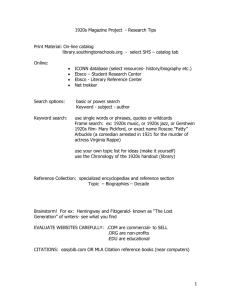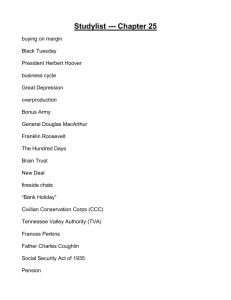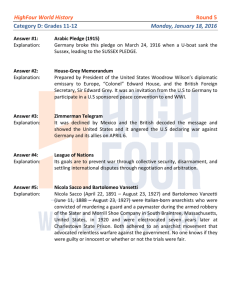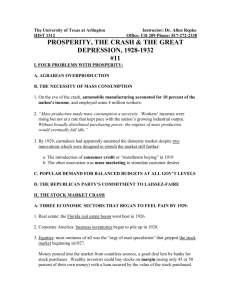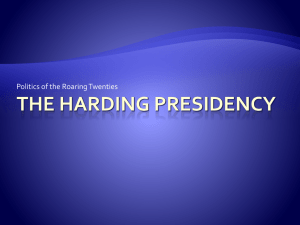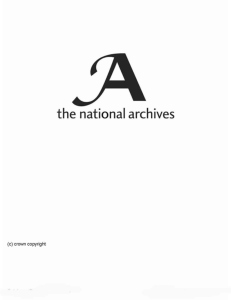THE ROARING TWENTIES
advertisement
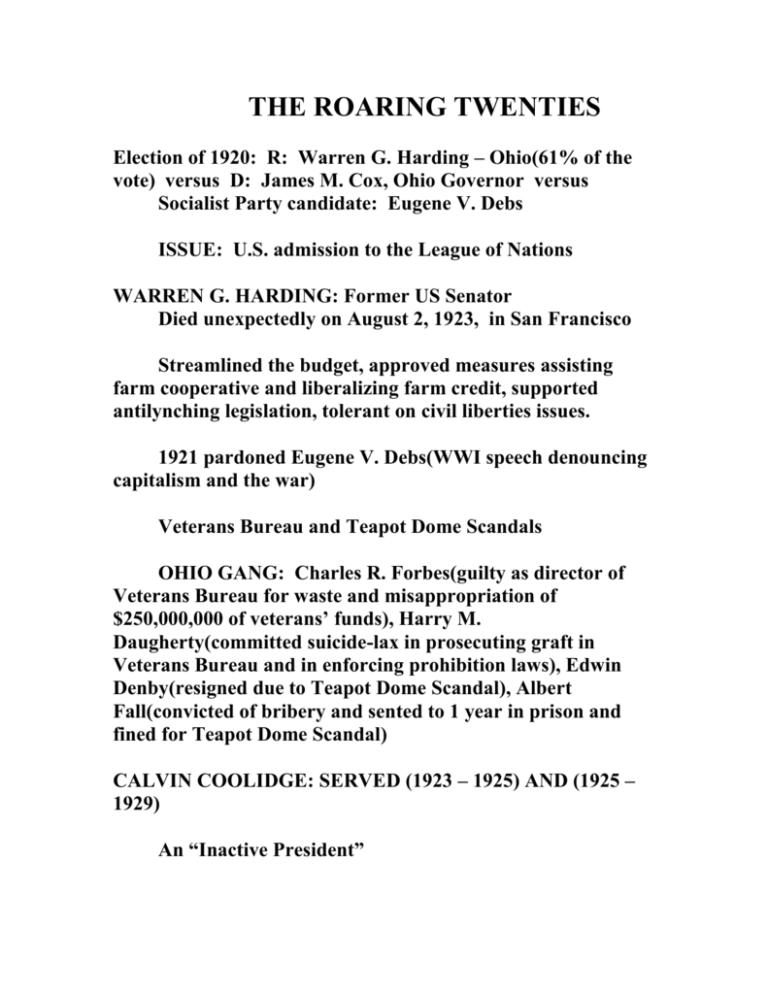
THE ROARING TWENTIES Election of 1920: R: Warren G. Harding – Ohio(61% of the vote) versus D: James M. Cox, Ohio Governor versus Socialist Party candidate: Eugene V. Debs ISSUE: U.S. admission to the League of Nations WARREN G. HARDING: Former US Senator Died unexpectedly on August 2, 1923, in San Francisco Streamlined the budget, approved measures assisting farm cooperative and liberalizing farm credit, supported antilynching legislation, tolerant on civil liberties issues. 1921 pardoned Eugene V. Debs(WWI speech denouncing capitalism and the war) Veterans Bureau and Teapot Dome Scandals OHIO GANG: Charles R. Forbes(guilty as director of Veterans Bureau for waste and misappropriation of $250,000,000 of veterans’ funds), Harry M. Daugherty(committed suicide-lax in prosecuting graft in Veterans Bureau and in enforcing prohibition laws), Edwin Denby(resigned due to Teapot Dome Scandal), Albert Fall(convicted of bribery and sented to 1 year in prison and fined for Teapot Dome Scandal) CALVIN COOLIDGE: SERVED (1923 – 1925) AND (1925 – 1929) An “Inactive President” Believed that “government should interfere as little as possible.” Secretary of the Treasury Andrew Mellon – responsibility for streamlining the federal budget and for reducing the nation’s WWI debt Secretary of Commerce Herbert Hoover, worked to promote a more efficient, better organized national economy. ELECTION OF 1924: R: COOLIDGE(easily won) v. D: JOHN W. DAVIS (FORMER AMBASSADOR TO GREAT BRITAIN) v. PROGRESSIVE: ROBERT LaFOLLETTE ELECTION OF 1928: R: HERBERT HOOVER(58% of the vote) defeated GOVERNOR OF N.Y. ALFRED E. SMITH(RCC) V. Socialist Party candidate, Norman Thomas ISSUE: Prohibition HERBERT HOOVER: Stock Market crash & beginning of the Great Depression THE ECONOMY: 1921 – 1922: Recession Unemployment remained 3-4% Farmers had a difficult decade Trends: to weaken the union movement and to remove causes of industrial discontent Union busting; union membership declined Overproduction of food led to a sharp decline in food prices and farm income. 1922: Highest tariff in US history (Fordney-McCumber Tariff) Material culture: Consumerism Growth of the motion picture industry Radio: newest instrument of mass culture NBC established in 1927 1929, 40% of American households had a radio Sports flourished “The Jazz Age” The automobile: Ford Model T & Ford Model A 1908 – 1927 American writers: The Lost Generation Ernest Hemingway H. L. Mencken Sinclair Lewis F. Scott Fitzgerald Eugene O’Neill – only Am. Playwright to win a Nobel Prize Women & Blacks “The new woman” – flapper: smoking, drinking, dancing wearing seductive clothes and makeup Activism: YWCA, League of Women Voters, Equal Rights Amendment HARLEM RENAISSANCE: Langston Hughes James Weldon Johnson Countee Cullen Zora Neale Hurston Claude McKay Alvin Locke Marcus Garvey – Universal Negro Improvement Association Responses to the new culture: Immigration Act of 1921 – quotas 1922 Cable Act Immigration Act of 1924 – further limitations; banned Asian immigration 1929 National Origins Act – limited quotas KKK Fundamentalism – Scopes “Monkey” Trial 18th Amendment: Prohibition Foreign Policy Washington Naval Conference 1921 – 1922 The Five-Power Pact 1922 The Nine-Power Pact The Four-Power Pact Geneva Naval Disarmament Conference 1927 London Naval Conference 1930 Kellogg-Briand Pact 1928 Dawes Plan 1924 Young Plan 1929 War-debt Moratorium Lusanne Conference 1932 The World Court DOLLAR DIPLOMACY IN LATIN AMERICA Hoover-Stimson Doctrine 1932 – response to the Japanese invasion of Manchuria 1931
